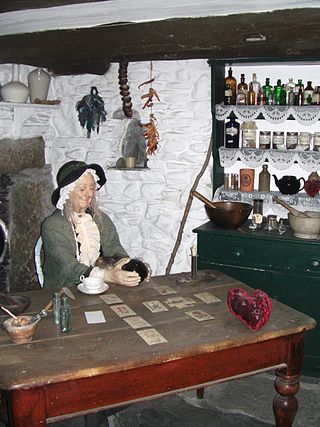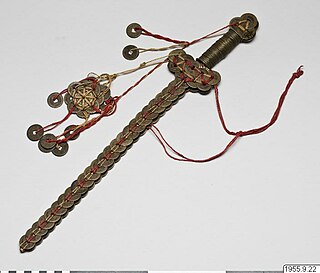
In ancient Mesopotamian religion, Pazuzu is a personification of the southwestern wind, and held kingship over the lilu wind demons.

The evil eye is a supernatural belief in a curse brought about by a malevolent glare, usually inspired by envy. The belief in the evil eye among humans has existed since prehistory, and amulets to protect against it have been found from dating to about 5,000 years ago. It is estimated that around 40% of the world's population believes in the evil eye.

A crystal ball is a crystal or glass ball commonly used in fortune-telling. It is generally associated with the performance of clairvoyance and scrying in particular. Other names include crystal sphere, gazing ball, shew stone, and show stone. In neopaganism it is sometimes called an orbuculum.

A witch bottle is a apotropaic magical item used as protection against witchcraft. They are described in historical sources from England and the United States. The earliest surviving mention is from 17th-century England.

The cimaruta is an Italian folk amulet or talisman, traditionally worn around the neck or hung above an infant's bed to ward off the evil eye. Commonly made of silver, the amulet itself consists of several small apotropaic charms, with each individual piece attached to what is supposed to represent a branch of rue—the flowering medicinal herb for which the whole talisman is named, "cimaruta" being a Neapolitan form of cima di ruta: Italian for "sprig of rue".

Apotropaic magic or protective magic is a type of magic intended to turn away harm or evil influences, as in deflecting misfortune or averting the evil eye. Apotropaic observances may also be practiced out of superstition or out of tradition, as in good luck charms, amulets, or gestures such as crossed fingers or knocking on wood. Many different objects and charms were used for protection throughout history.
Romani folklore encompasses the folktales, myths, oral traditions, and legends of the Romani people. The Romani were nomadic when they departed India during the Middle Ages. They migrated widely, particularly to Europe, while other groups stayed and became sedentary. Some legends say that certain Romani have passive psychic powers such as empathy, precognition, retrocognition, or psychometry. Other legends include the ability to levitate, travel through astral projection by way of meditation, invoke curses or blessings, conjure or channel spirits, and skill with illusion-casting. The belief in vampires originated from the Roma. The Roma from Slavic countries believe in werewolves. Romani chovihanis often use a variety of herbs and amulets for protection. Garlic is a popular herb used by the Roma.

The hamsa, also known as the hand ofFatima, is a palm-shaped amulet popular throughout North Africa and in the Middle East and commonly used in jewellery and wall hangings. Depicting the open hand, an image recognized and used as a sign of protection in many times throughout history, the hamsa has been traditionally believed to provide defense against the evil eye.

Gris-gris is a Voodoo amulet originating in West Africa which is believed to protect the wearer from evil or bring luck, and in some West African countries is used as a purported method of birth control. It consists of a small cloth bag, usually inscribed with verses from an ancestor and a ritual number of small objects, worn on the person.

An amulet, also known as a good luck charm or phylactery, is an object believed to confer protection upon its possessor. The word "amulet" comes from the Latin word amuletum, which Pliny's Natural History describes as "an object that protects a person from trouble". Anything can function as an amulet; items commonly so used include statues, coins, drawings, plant parts, animal parts, and written words.

A kitchen witch, sometimes called a cottage witch is a homemade poppet or doll resembling a stereotypical witch or crone displayed in residential kitchens as a good luck charm and to ward off bad spirits.
Buda, in Ethiopian and Eritrean folk religion, is the power of the evil eye and the ability to change into a hyena. Buda is generally believed by the wider society to be a power held and wielded by those in a different social group, for example among the Beta Israel or metalworkers. The belief is also present in Sudan, Tanzania, and among the Berber people in Morocco.

Cunning folk, also known as folk healers or wise folk, were practitioners of folk medicine, helpful folk magic and divination in Europe from the Middle Ages until the 20th century. Their practices were known as the cunning craft. Their services also included thwarting witchcraft. Although some cunning folk were denounced as witches themselves, they made up a minority of those accused, and the common people generally made a distinction between the two. The name 'cunning folk' originally referred to folk-healers and magic-workers in Britain, but the name is now applied as an umbrella term for similar people in other parts of Europe.

Concealed shoes hidden in the fabric of a building have been discovered in many European countries, as well as in other parts of the world, since at least the early modern period. Independent researcher Brian Hoggard has observed that the locations in which these shoes are typically found – in chimneys, under floors, above ceilings, around doors and windows, in the roof – suggest that some may have been concealed as magical charms to protect the occupants of the building against evil influences such as demons, ghosts and witches. Others may have been intended to bestow fertility on a female member of the household, or been an offering to a household deity.
An azusa yumi is a sacred bow (yumi) used in certain Shinto rituals in Japan, as well as a Japanese musical bow, made from the wood of the Japanese azusa or Japanese cherry birch tree. Playing an azusa yumi forms part of some Shinto rituals; in Japan, it is believed that merely the twanging of the bowstring will frighten ghosts and evil spirits away from a house. In Japanese poetry, the word azusa yumi functions as a makurakotoba.
A troll cat is the familiar of a witch in Scandinavian folklore. Troll cats sucked milk from cows and spat it out in the witches' milk pails, and went into homes to lick up cream. Aside from cats, similar creatures include the milk rabbit, milk hare, and ball-shaped troll ball.
A hōko is a kind of soft-bodied doll given to young women of age and especially to pregnant women in Japan to protect both mother and unborn child. Traditionally, hōko dolls were made of silk and human hair, and stuffed with cotton. The dolls could be made for both boys and girls. Boys' dolls would be given up and "consecrated" at a shrine when boys came of age at 15 years old, while girls would give up their dolls at marriage. The dolls were given to children either at birth, or on special days shortly after birth. Pregnant woman would be given new ones, so as to protect her and her unborn child together, for the duration of the pregnancy.

An apotropaic mark, also called a witch mark or anti-witch mark, is a symbol or pattern scratched on the walls, beams and thresholds of buildings to protect them from witchcraft or evil spirits. They have many forms; in Britain they are often flower-like patterns of overlapping circles.

Coin-swords, or cash-swords, are a type of Chinese numismatic charms that are a form of feng shui talisman that were primarily used in southern China to ward off evil spirits and malicious influences, especially those inducing fever. These coin-swords are also often used in Taoist rituals. Coin-swords are considered an "evil-warding sword" in China.















